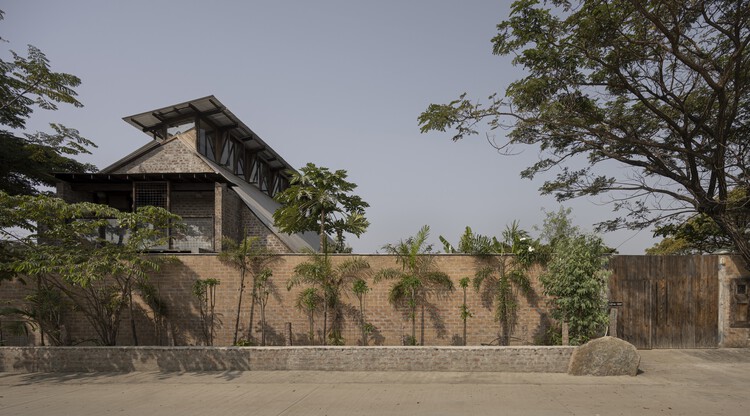





Text description provided by the architects. In collaboration with a former architecture classmate, this residential project embraced design flexibility. The key challenge involved the loose black cotton soil, rendering traditional foundations impractical. To address this, pile foundations were implemented, transferring weight to deeper, stable soil layers. This reduced overall building load optimizing both structural efficiency and project cost.

This project embraced wood as the primary building material, eliminating the use of steel above ground level. This choice not only aligns with sustainable building practices but also contributes to the unique aesthetic of the structure. The project allows innovation when traditional constraints are relaxed, highlighting the successful collaboration between an architect and a non-professional. Embracing a modular grid system influenced everything from precise window and door placement to optimal room sizes. This approach ensures doors seamlessly align with columns while multiplying grid units dictates specific room dimensions—a 3′-9″ module, for example, generates an ideal 11′-3″ bedroom and a 15′ living room.


The lightweight construction approach optimizes structural efficiency and cost. MADDI Karra, indigenous to Andhra and Telangana, was chosen for its inherent strength, density, and natural termite resistance. This choice aligned with sustainability goals and reduced the need for chemical treatments or extensive finishing. However, working with MADDI presented difficulties due to its density. Despite advancements in equipment, carpentry posed challenges due to the wood’s hardness and cutting requirements. Limited prior experience with the material also necessitated experimentation.



The interior atmosphere prioritizes a sense of cohesion through material selection and design. A consistent color palette featuring earthy tones like red brick, orange wood, and cream flooring, which are compatible with each other, unifies the space. The exposed wood’s distinct pattern further enhances the visual connection between elements. This deliberate material harmony contributes significantly to the overall ambiance of the building. Drawing inspiration from traditional Japanese joinery techniques, the design team explored various methods for seamless connections. Collaborative efforts with the carpenter and structural engineers ensured the implementation of appropriate joinery methods that aligned with both aesthetic intent and structural integrity. This approach emphasizes blending traditional craftsmanship with modern design principles.



The building incorporates a unique design element for optimizing natural ventilation and mosquito control. These vertically projecting elements, visible in night-time images, serve a specific functional purpose beyond aesthetics. Users can easily open and close them from ground level using the rope, and when released, gravity tilts the wood shutter outward for efficient air circulation while preventing mosquitoes. This angled closure ensures a tight seal when closed, maximizing both ventilation and mosquito protection. Furthermore, the design facilitates hot air removal through natural convection and complements strategic window placement for effective cross-ventilation and indirect north-facing light, minimizing heat gain.

Forgoing gutters at the roof’s edge allows rainwater to cascade directly into the surrounding landscape. This intentional design, complemented by the generous distance between the house and the landscaping, maximizes the natural ambiance experienced by the living room. Illuminated at night, the building transforms into a glowing lantern, beckoning with its warm light.


